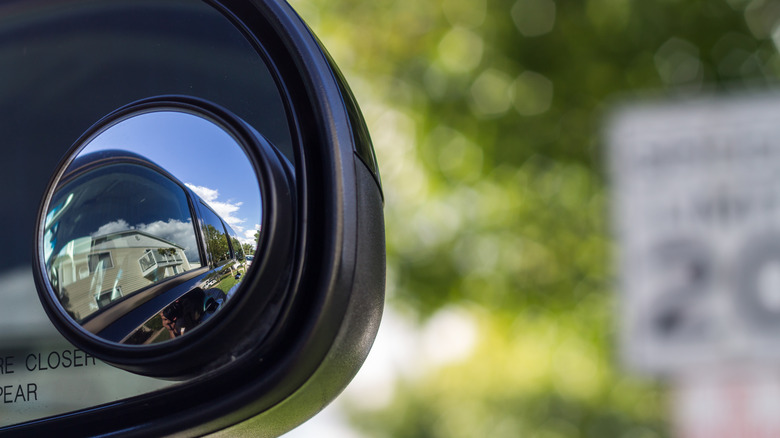Blind Spot Mirrors: How Do They Work And Are There Any Drawbacks?
Mirrors weren't always mandatory on cars, and now, they're not only required, but power-folding, heated, and come packed with smart safety tech. Having first appeared in 2003 on the Volvo XC90, blind spot monitoring technology is now becoming more and more common, and for good reason, too. There is no doubt that the technology helps us to drive safer, and for older vehicles that aren't equipped with this tech, blind-spot mirrors can help somewhat. These are smaller mirrors which simply stick on to the standard glass. Thanks to a convex finish, they deliver a wider field of view, allowing the driver to see more than they would be able to with those standard mirrors alone.
Whilst mirrors do a great job of showing most of what's behind us, they can't always show us everything, and that can be especially dangerous when merging onto a highway or switching lanes. This is where blind-spot detection, or BSD, systems, and those adhesive blind-spot mirrors come in. The former use cameras and sensors to identify cars or other obstacles in blind spots and then notify us, either via a light on the mirror or by a dashboard alert, while the latter provide a much simpler answer.
Fortunately, while it's not easy to incorporate a full blind-spot monitoring system, applying blind-spot mirrors onto our standard side mirrors is quick and easy. Most are simply backed with adhesive tape, and can be stuck on in a matter of seconds. This is a great option for those with older vehicles who don't feel like forking out for a new car, or attempting to retrofit a fiddly aftermarket BSD system.
Drawbacks of blind-spot mirrors
In theory, blind-spot mirrors make a heap of sense. However, as with almost any great idea, there will always be drawbacks too. The first downside to these mirrors is quite obvious; they cover up part of your standard side mirror, which in turn, hides part of what you would usually see. Now, while that hidden portion will probably be displayed in the blind-spot mirror now, it'll be much smaller, and harder to see — especially with a quick flick of your neck when driving at highway speeds.
That's the next issue — size. They have to be small so they don't detract too much from your mirror's usual display, but how useful is the image displayed by the blind-spot mirror if it's that small? This could pose issues for those with poorer sight especially, and in this instance, a full monitoring system probably is the best solution.
Another drawback is that they are only held on by adhesive, and so they can fail and fall off, particularly if the mirror wasn't cleaned properly before applying. This could be frustrating if, when you go to check it, it isn't there, and may take you off-guard when trying to complete a maneuver on the road. Finally, they are only as effective as you allow them to be. If you apply it wonkily or in the wrong place, you may as well have just covered that portion of your mirror with black electrical tape, although we're not sure 'user error' really counts as a drawback of the design itself. The use of adhesive also makes it tricky to reuse them also, should you buy a new car, or wish to reposition them.
The positives could outweigh the negatives still
It's easily understandable that drivers, especially those that cover a lot of miles on busy freeways, would want to see more of what's behind them, in order to merge and change lanes confidently. They can be great for reversing too, to ensure no annoying posts are hiding away where you cannot see.
Furthermore, while blind-spot monitoring systems are fantastic for the most part, for many of us, having such a feature requires buying a new car. That's a considerable outlay, especially just for a safety device. While aftermarket kits do exist, not everyone is going to be confident wiring something like that in, and they aren't always cheap either, so that's not a widespread fix, unlike these adhesive mirrors which can be picked up for just a few dollars. The bottom-line is that some will make great use of these little mirrors, and if they help to keep even a small minority of motorists in older cars feeling safe and confident behind the wheel, then it's a great addition to have.


